Emailing price changes to your current customer base can be a hurdle. But we’ve got you covered. In this piece, we’ll explore key tips for crafting effective price update emails.
1. Prioritize clarity and transparency
Updating customers about revamped (increased) prices requires clarity and honesty.
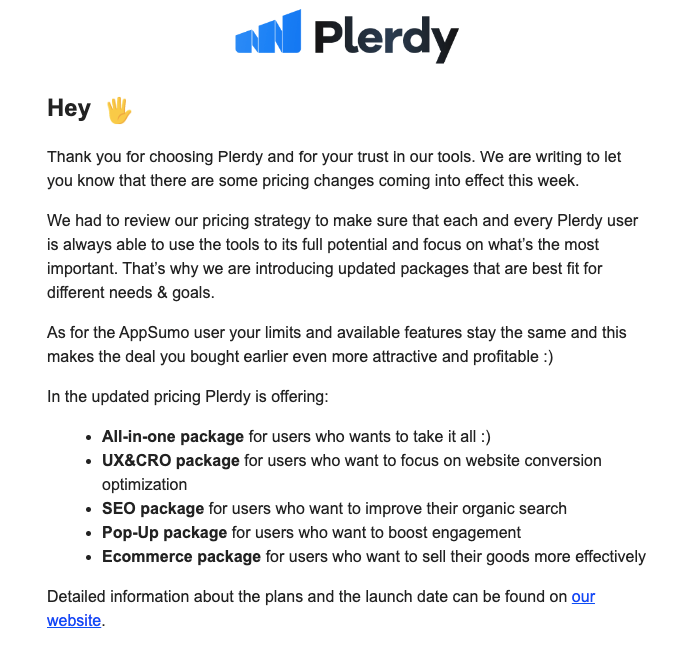
(Source: Email from Plerdy)
The email explains what’s changing, why, and how the changes benefit the user without resorting to jargon or complex terminology.
Here’s what you can do when crafting such an email:
Come up with a clear subject line
The subject line is your first impression. Use clear, respectful language that acknowledges the significance of a pricing update.
For example, “Important Update: Changes to Your Pricing Plan Effective [Date].”
Also, avoid language that might cause panic or confusion. Words like “urgent” or “alert” can create unnecessary concern.
Provide a detailed breakdown
Clearly outline what the pricing was and what it will be. It is a good practice to send customized billing details, particularly for larger accounts. The custom quotes tell your customers how much they will pay and for what, which can be pivotal after you change your pricing.
SaaS businesses can consider a CPQ quoting tool to automate this process. These apps pull all the usage details of your customers from the CRM and provide them with itemized quotes based on the pricing update.
A detailed breakdown can be presented in a table or side-by-side comparison for easy understanding.
Segment your users
If applicable, introduce segmentation. For instance, prices may vary by user type or service tier. Here, segmenting can make sure everything is clear. In this way, you Updating customers about only the information relevant to their plan.
Such personalized pricing update emails require segmenting your audience based on their unique interaction patterns and pricing plans.
Provide reasons
Explain the change. Is it due to enhanced features, increased operational costs, or market adjustments? Be as specific as possible. Also, acknowledge how the new prices will help maintain and improve service quality.
The email should also assure customers that this decision was made carefully and in their best interest.
2. Offer value, not just a price change
The price change may generate criticism, and you may risk losing your customers. Therefore, when communicating this change, emphasize your SaaS product’s value.
For instance, Google paired pricing updates with new features or enhancement announcements.
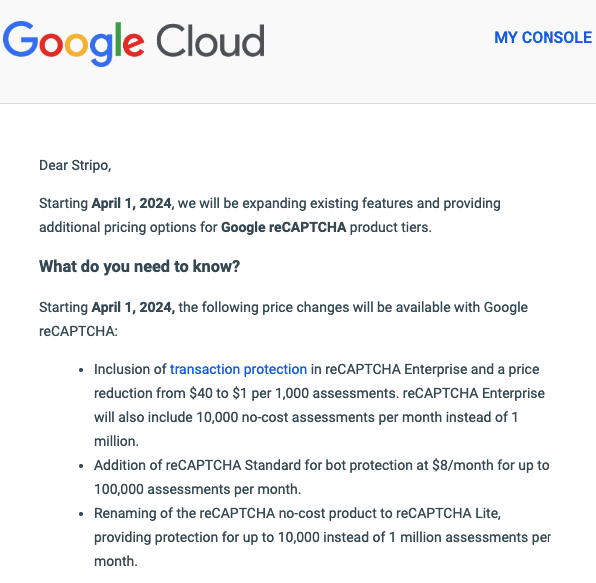
(Source: Email from Google Cloud)
This sort of communication reinforces the idea that increased costs bring increased value.
The new features are explained briefly, and links are provided, enabling customers to learn more about it.
Here are some key tips on how to manage such communications:
Highlight enhancements
Use the pricing update email to highlight new features or improvements. Describe how these changes will enhance the user experience or provide new capabilities.
Also, include testimonials or case studies demonstrating the benefits of the new features. Such real-world examples can help users understand the practical value these changes bring.
Utilize feature insights
Analyze individual user data to identify customers’ most and least used features. Customize email communication to highlight enhancements or changes in their frequently used features. This educates them on the value of underutilized features in their current plans.
Include these options directly in the email, making it clear that you’re dedicated to finding a solution that works for them.
3. Emphasize timing and gradual transition
The price rise in a SaaS product can make customers rethink their choices. Therefore, you must crack effective timing and a well-thought-out transition period. This can significantly soften the impact of a pricing update.
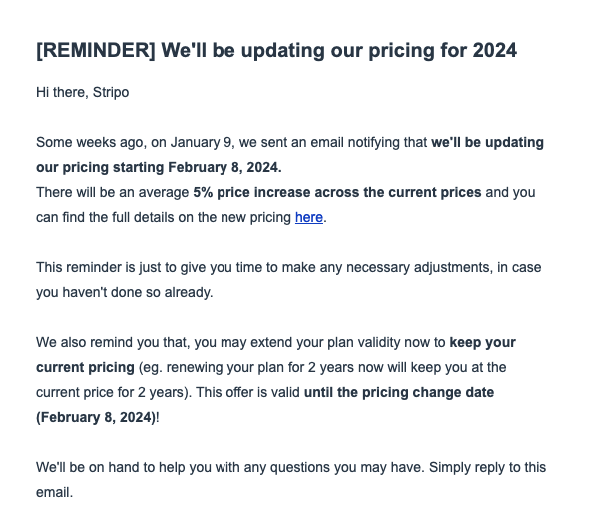
(Source: Email from E-goi)
Give advance notice
Provide customers with ample time before the new pricing takes effect.
A 30- to 60-day notice can be considered respectful, yet some companies prefer communicating price changes around 90 days out, which is ideal.
This, in a way, allows users to familiarize themselves with new features that justify the price hike.
Let existing customers pay their current prices
If the pricing update might negatively impact the user, proactively offer solutions, like temporarily allowing them to maintain their current rate.
This strategy allows existing customers to continue paying their current price for a set period, even after a new pricing structure is introduced.
Moosend, a famous marketing automation platform, announces pricing changes months in advance:
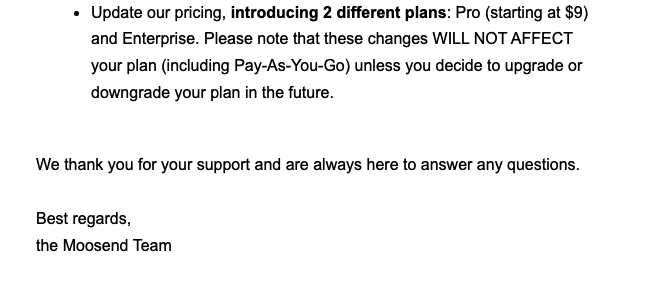
(Source: Email from Moosend)
4. If the feature update is too long, include a CTA
Sometimes concisely putting all the pricing updates into one email can be difficult. This can be more true for businesses that offer custom pricing, have multiple tiers, or primarily cater to enterprise clients.
In those cases, you can simply announce that you have updated the pricing for your products and services and provide a link to an external resource containing additional details. That’s where a call-to-action (CTA) comes in.
A clear CTA is essential to guide customers on what steps they need to take next. Whether it is to review the new pricing details, access additional resources, or contact support, the CTA should be unmistakable and easy to find.
For instance, Amazon Web Services communicated a price rise without revealing the revised rate.
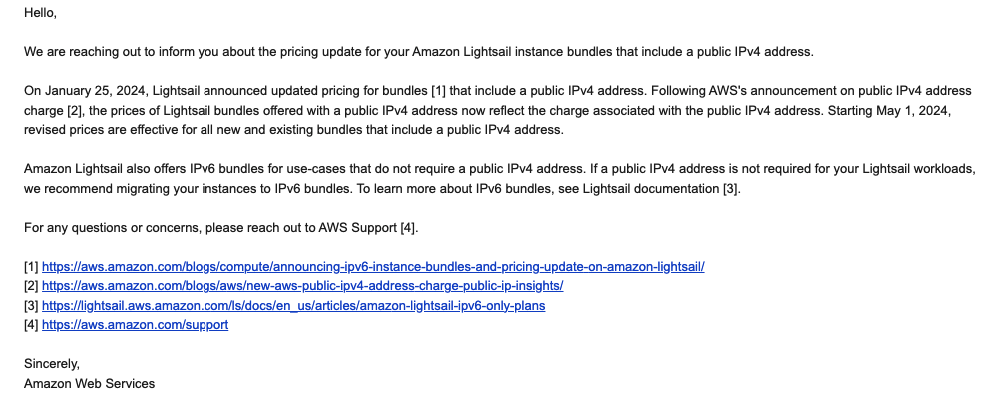
(Source: Amazon Web Services)
An effective CTA goes beyond just completing the communication. It should facilitate a seamless transition for the customer and ensure they remain engaged and well-informed.
Make it easy to take action
Embed direct links in your CTA that take customers to the exact page they need to be on to respond to the new pricing.
If they need to review their subscription options, the link should take them to a specific page, not just to your website’s homepage.
Now, regarding visibility, your CTA should stand out visually. Use buttons with contrasting colors or place the CTA in an immediately noticeable part of the email. This reduces friction and encourages action.
5. Mind the tone
The language and tone you adopt in your pricing update email play a critical role in shaping how your audience perceives and receives your message.
Opting for an empathetic tone goes beyond mere courtesy; it reflects a deeper understanding of and genuine concern for the potential impact that such changes might have on your customers.
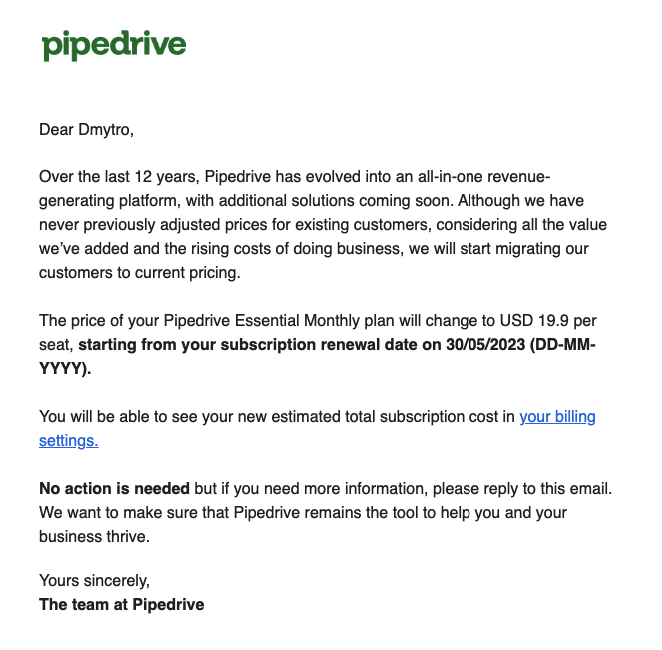
(Source: Email from Mailerlite)
You can use phrases like “We understand this might come as a surprise…” or “We recognize the challenges that come with changes…” to resonate with the audience and help them feel seen and understood.
Use an empathetic and respectful tone
Think of how you can use language to have a positive impact on customers. Your words should convey understanding and care.
For instance, instead of saying, “Prices will increase,” you could say, “We’ve adjusted our prices to better reflect the value and the quality of enhancements we’re committed to providing you.”
Wrapping up
Overall, just like any other type of SaaS business email, price rise communications require navigating complexities. However, the above-mentioned tips can help you form a thoughtful, customer-centric approach to communicating SaaS product pricing.
The challenges involve retaining customers after a price change and transforming this communication into an opportunity to foster dialogue. Understanding the diverse needs and perceptions of customers is crucial to providing pricing support and options.
A positive conversation centered on transparency, personalization, and clear guidance can transform the challenge of a pricing update into an opportunity to strengthen trust, reinforce value, and deepen customer relationships.
Design effective pricing update emails with Stripo

